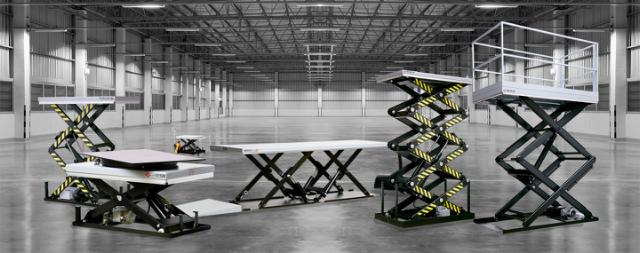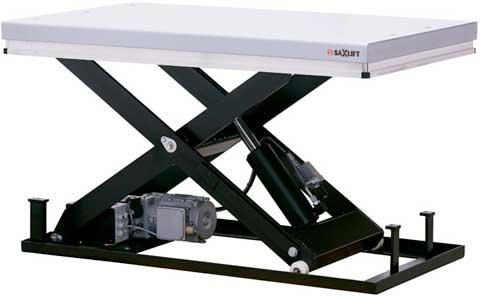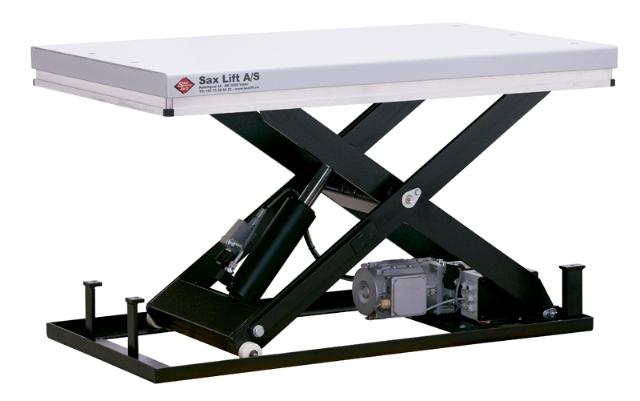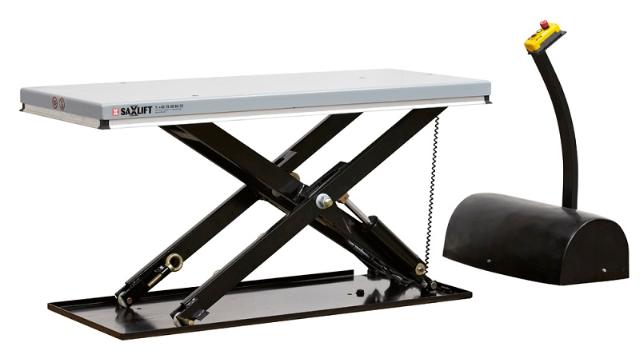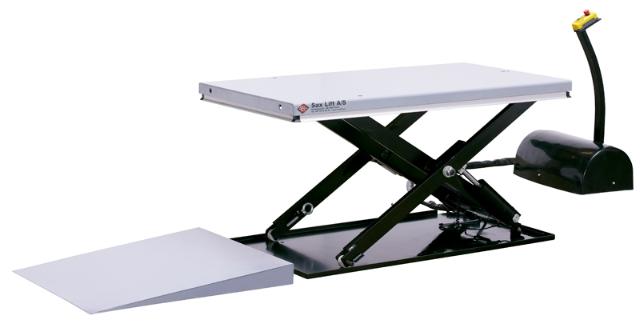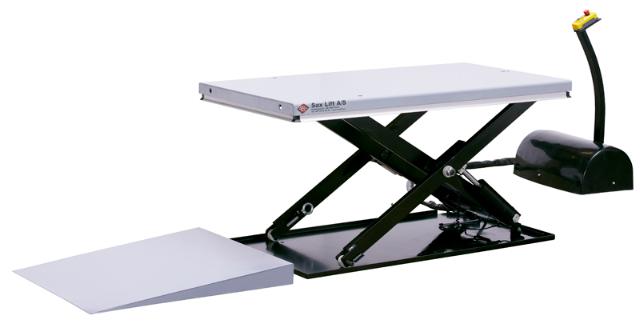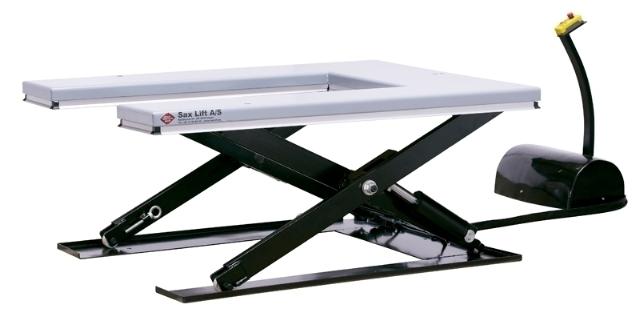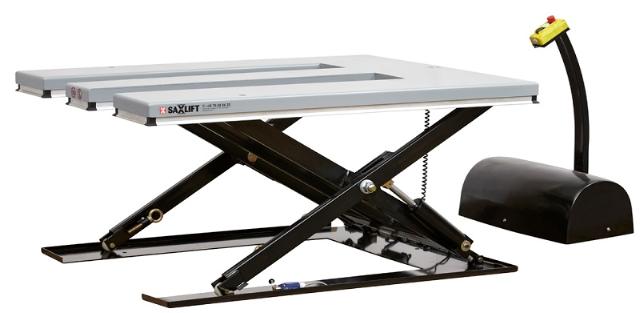230V Lift tables
Electric Lift Table: Versatile Pallet Lift Solutions
Electric lift tables have revolutionized the way industries handle pallet lifting, offering a versatile solution for various applications.
These innovative tools enhance workflow efficiency and safety, making them indispensable in warehouses and manufacturing facilities. With their ability to lift heavy loads effortlessly, electric lift tables minimize manual handling risks, reducing workplace injuries.
Among their diverse configurations, the scissor lift mechanism stands out for its exceptional stability and precision.
Models like the IL1000X-230V Single Scissor Lift Table boast a robust capacity of 1000 kg and a platform length of 1300 mm, ideal for heavy-duty tasks.
The ILH1500X-230V Tandem Scissor Lift Table, with its impressive 1500 kg capacity and extended platform length of 2600 mm, caters to even more demanding applications, underscoring the versatility and reliability of electric lift tables.
What is an Electric Lift Table?
An electric lift table is a specialized device designed to elevate materials with ease, often utilizing a scissor mechanism powered by an electric motor.
These tables operate by extending and retracting the scissor arms, providing smooth and controlled lifting action.
Commonly used in warehouses and manufacturing facilities, electric lift tables enhance productivity and safety by efficiently handling heavy loads.
Definition of Electric Lift Table
A marvel of modern engineering, the electric lift table revolutionizes the way heavy loads are managed in various industries.
These tables, often designed with a scissor lift table mechanism, provide a reliable solution for lifting and lowering tasks. Powered by electricity, they offer a seamless operation, enhancing productivity and reducing the physical strain associated with manual handling.
Electric lift tables are preferred for their precision and ease of use, allowing operators to adjust the height of the platform to the exact level required for efficient workflow.
This adaptability makes them indispensable in settings like warehouses, factories, and distribution centers. With various capacities and platform sizes, like the ILH1500X-230V tandem model, they cater to different load requirements, ensuring versatility across applications.
How Does an Electric Scissor Lift Work?
When understanding the mechanics of an electric scissor lift, it's crucial to recognize the seamless coordination of its components. At the core of these devices is an electric motor, powering the scissor mechanism through hydraulic or screw-driven systems. This guarantees smooth, precise electric lifting, offering stability and control. As the motor engages, it extends the scissor arms, raising the platform to the desired height.
Consider the following table detailing the emotional impact of a well-functioning scissor lift:
| Emotion | Description | Impact on User |
|---|---|---|
| Confidence | Reliable lifting operations | Enhanced productivity |
| Safety | Secure lifting mechanism | Peace of mind |
| Satisfaction | Effortless and smooth operation | Increased efficiency |
| Trust | Consistent performance over time | Long-term reliability |
This intricate dance of components results in a robust, dependable tool for various lifting needs.
Common Applications for Electric Lift Tables
Electric scissor lifts, with their intricate mechanics and reliable performance, find their place in a wide array of applications.
Warehouses often employ lift tables to handle goods efficiently, utilizing their adjustable height features to transport and position heavy items. In manufacturing, these tables streamline assembly lines, facilitating the movement of components and finished products. The robust load capacity of electric lift tables makes them ideal for heavy-duty tasks, enhancing productivity and safety.
In automotive workshops, lift tables assist in vehicle repair and maintenance, providing mechanics with easy access to different parts.
Retail environments benefit from lift tables too, aiding in the arrangement and stocking of inventory.
Additionally, hospitals and laboratories use them for handling sensitive equipment, and maintaining precision and care during operations.
What are the Key Features of a 230V Scissor Lift Table?
When examining the key features of a 230V scissor lift table, one should consider the benefits of its electric operation, such as improved efficiency and reduced manual effort.
Understanding the maximum lift height of these models is essential, as it determines their suitability for various tasks.
Additionally, the load capacity greatly impacts performance, with different models offering capacities ranging from 500 kg to 1500 kg.
>Benefits of Using a 230V Electric Lift Table</h3
Though often overlooked, the benefits of using a 230V electric lift table are considerable for enhancing operational efficiency and safety in industrial settings.
These tables, powered by a reliable 230V system, offer seamless integration into existing electrical setups. The hydraulic mechanism guarantees smooth and precise lifting, reducing manual handling and minimizing injury risks.
Additionally, the robust design of these tables supports considerable weight capacities, making them ideal for heavy-duty tasks. Their versatility allows for handling various materials and equipment, streamlining workflow and increasing productivity.
Furthermore, the quiet operation of 230V lift tables contributes to a more pleasant working environment, as noise pollution is greatly reduced.
Ultimately, investing in a 230V electric lift table enhances both safety and performance in demanding industrial applications.
Understanding the Max Lift Height of 230V Models
While evaluating lift tables, understanding the maximum lift height of 230V models is essential for ensuring they meet specific operational needs. Each model offers different lift heights and capacities, catering to various industrial applications.
For instance, the ICB500-230V Low Profile Lift Table achieves a maximum lift height of 880 mm with a 500 kg capacity, making it suitable for moderate workloads. Conversely, the ILH1500X-230V Tandem Scissor Lift Table reaches an impressive 1040 mm, supporting up to 1500 kg, ideal for heavier tasks.
The IU600-230V and IU1000-230V models, with 860 mm and 880 mm lift heights respectively, also provide robust solutions with their unique capacities.
Ultimately, selecting the right lift table depends on matching these specifications to the intended operational requirements.
Load Capacity and Performance of Electric Scissor Lifts
Building on the understanding of lift heights in 230V models, examining load capacity and performance is key to selecting the right electric scissor lift.
Each model offers unique capacities, ensuring diverse operational needs are met. For instance, the ICB500-230V and IU600-230V models boast load capacities of 500 kg and 600 kg, respectively, making them ideal for moderate lifting tasks.
In contrast, the IL1000X-230V and IU1000-230V models handle up to 1000 kg, catering to heavier loads. The ILH1500X-230V, with a 1500 kg capacity, is perfect for demanding applications needing robust support.
Performance efficiency is enhanced by factors like platform length and travel height, ensuring tasks are completed safely and effectively.
Choosing the right scissor lift depends on matching these factors to specific operational requirements.
What is the Maximum Lift Height of Scissor Lift Tables?
When considering scissor lift tables, understanding the standard lift heights is essential for selecting the right model for specific tasks.
With variations in maximum lift heights, such as the IL1000X-230V and ILH1500X-230V models reaching up to 1040 mm, it's important to match the lift's capabilities with operational needs.
Additionally, ensuring safety at these heights requires careful attention to factors like weight capacity and stability.
Standard Lift Heights for Electric Scissor Lifts
Electric scissor lift tables offer a range of standard lift heights that cater to various industrial needs.
These tables are designed to accommodate different lifting requirements, providing maximum efficiency and safety. For instance, models like the ICB500-230V and IU1000-230V present a lift height of up to 795 mm, while the IL1000X-230V single scissor lift table reaches a maximum of 860 mm.
The ILH1500X-230V tandem scissor lift table extends even further, offering a lift height of 865 mm, ideal for more demanding applications.
These variations guarantee that businesses can choose the appropriate lift height for their specific tasks, enhancing productivity and ergonomics in the workplace.
Hence, selecting the right scissor lift table is vital to optimizing operational efficiency.
How to Choose the Right Lift Height for Your Needs
Selecting the correct lift height is a key factor in maximizing the functionality and efficiency of a scissor lift table. Different applications require different lift heights, and understanding these can make all the difference.
Here are some steps to help choose the right lift height:
-
Determine the Load Height: Identify the maximum height needed to safely position and handle the load. This guarantees the lift can accommodate your requirements.
-
Consider the Work Environment: Measure the ceiling height and any obstacles that might restrict lift operation.
-
Evaluate the Table's Capacity: Verify the table's capacity can support the intended load at the desired height.
-
Review Product Specifications: Compare specifications like travel distance and total height among models such as the IL1000X-230V or ILH1500X-230V to find the best fit.
Safety Considerations for Maximum Lift Heights
While guaranteeing safety in operation, understanding the maximum lift height of scissor lift tables is vital to prevent accidents and equipment malfunctions. Different models offer varying heights, and it's important to align these with safety standards, especially when handling heavy loads. Overextending a lift table can lead to instability, risking worker safety and damaging equipment.
| Model | Maximum Lift Height (mm) |
|---|---|
| ICB500-230V | 880 |
| IU600-230V | 860 |
| IL1000X-230V | 1040 |
| ILH1500X-230V | 1040 |
The table above highlights maximum lift heights, significant for planning operations involving heavy loads. Operators should always adhere to the specified limits to maintain safety, especially when using equipment that supports you when lifting heavy loads. Regular maintenance checks guarantee the lifting mechanisms function correctly, further reducing risks associated with high lift operations.
What is the Load Capacity of Electric Scissor Lifts?
Electric scissor lifts come with varying load capacities, ranging from 500 kg to 1500 kg, which are vital for determining their suitability for different tasks.
Understanding the capacity ratings, especially the common 1000 kg models, helps users evaluate which lift best meets their load requirements.
Several factors, such as the lift's design and platform size, can affect its load capacity, making it essential to take into account these elements when selecting the right scissor lift.
Understanding Capacity Ratings: 1000kg vs Other Models
Understanding the load capacity of electric scissor lifts is essential, particularly when comparing models with a 1000 kg capacity to others with different ratings.
A hydraulic lift table with a 1000 kg capacity, such as the IL1000X-230V, offers robust lifting capabilities suitable for various applications.
Here's a quick comparison of different models:
-
ICB500-230V Low Profile Lift Table: With a capacity of 500 kg, this model is ideal for lighter loads.
-
IU600-230V U-shape Low Profile Lift Table: Offering a 600 kg capacity, it provides a middle-ground solution.
-
IL1000X-230V Single Scissor Lift Table: Handles up to 1000 kg, perfect for heavier demands.
-
ILH1500X-230V Tandem Scissor Lift Table: With a 1500 kg capacity, it's the go-to option for even heavier lifting needs.
Factors Affecting the Load Capacity of Lift Tables
Though their design might seem simple, several factors influence the load capacity of lift tables. The scissor lift mechanism itself is fundamental, with its robustness directly affecting how much weight it can handle, especially in a 230V single phase setup.
Material quality also plays a significant role; high-grade stainless steel offers enhanced durability and strength, contributing to greater load capacity.
The hydraulic system's efficiency is another vital aspect, as it determines how smoothly and safely the lift table can elevate heavy loads.
Additionally, the platform size impacts weight distribution, influencing the overall capacity.
Manufacturers often incorporate safety margins into their designs to guarantee dependable performance under specified conditions.
All these factors combined determine the load capacity of a scissor lift, making it essential to take them into account when evaluating lift table options.
Choosing a Scissor Lift Based on Load Requirements
Selecting the right scissor lift involves understanding the specific load requirements for your tasks.
It's crucial to match the lift's capacity with the demands of your operations to guarantee safety and efficiency.
When choosing a scissor lift, consider the following:
-
Capacity Needs: Determine the maximum weight that will be lifted regularly and choose a scissor lift that meets or exceeds this capacity. For example, the IL1000X-230V can handle up to 1000 kg.
-
Platform Size: Match the platform size to the dimensions of the loads you'll be moving. Larger platforms like the ILH1500X-230V, with a capacity of 1500 kg, provide more space.
-
Lift Height: Verify the lift can reach the necessary heights for your tasks.
-
Frequency of Use: Consider how often the lift will be used to guarantee durability and longevity.
How to Select the Right Electric Scissor Lift for Your Needs?
Selecting the right electric scissor lift involves considering several key factors to guarantee it meets specific needs.
It's crucial to assess the platform size and width, as these determine how well the lift will fit into the intended workspace and handle the required tasks.
Additionally, evaluating the robustness and comparing hydraulic versus electric options will help in deciding which lift offers the best performance and delivery solutions for the job.
Determining the Right Width and Platform Size
Determining the right width and platform size is essential when selecting an electric scissor lift, as it directly impacts the efficiency and safety of operations.
The lift table lifting capabilities and platform dimensions play a vital role in fitting the workspace and handling materials effectively.
Here's how to make an informed choice:
-
Assess Load Capacity: Consider the weight of materials. For instance, the IL1000X-230V supports up to 1000 kg.
-
Evaluate Platform Length: Longer platforms, like the ILH1500X-230V with 2600 mm, accommodate more or larger items.
-
Check Height Requirements: The travel height impacts reach. IL1000X-230V offers a travel of 860 mm.
-
Consider Application: Confirm the lift fits specific tasks. A U-shape platform might suit specific loading needs.
These factors guarantee ideal lift table selection.
Evaluating the Robustness and Delivery Options
When choosing the right electric scissor lift, considering the platform size and width is only part of the equation. Evaluating the robustness and delivery options is essential in guaranteeing the lift's efficiency and longevity. A robust design guarantees the lift can handle heavy loads and frequent use without compromising safety. For instance, models like the ILH1500X-230V offer a capacity of 1500 kg, showcasing durability.
| Model | Capacity (kg) |
|---|---|
| ICB500-230V | 500 |
| IU600-230V | 600 |
| ILH1500X-230V | 1500 |
Delivery options also play a significant role in deciding which lift to purchase. Buyers should consider the ease and speed of delivery to minimize downtime. Opting for a supplier with reliable delivery services can guarantee timely installation and operation.
Comparing Hydraulic and Electric Lift Tables
How can one effectively choose between hydraulic and electric lift tables?
It's important to understand their strengths and applications. Hydraulic lift tables are known for their robustness and are a good fit for heavy-duty tasks, providing consistent power.
On the other hand, electric lift tables offer precision and are ideal for environments where quiet operation is essential.
When considering which type is better suited for your needs, think about the following factors:
-
Loading requirements: Hydraulic tables are great for heavy loads; electric tables excel in precise positioning.
-
Maintenance: Hydraulic systems may require more maintenance than electric ones.
-
Operational noise: Electric tables are quieter, and suitable for noise-sensitive areas.
-
Budget: Evaluate cost differences; hydraulic tables might have a lower upfront cost but higher maintenance expenses.
What are the Benefits of Using a Scissor Lift Table?
Scissor lift tables, especially when electric, greatly enhance efficiency by streamlining lifting tasks and reducing manual labour.
They also play an essential role in improving safety in industrial settings, minimizing the risk of injuries associated with heavy lifting.
With various models available, such as the ICB500-230V and ILH1500X-230V, businesses can find the perfect fit for their specific capacity and height requirements.
Efficiency Gains with Electric Lifting Solutions
Although businesses constantly seek ways to enhance operational efficiency, electric lifting solutions like scissor lift tables offer significant benefits over traditional methods.
Scissor lift tables streamline processes by providing consistent lifting capabilities, and accommodating different weights and sizes. For example, a double scissor lift table can handle heavy loads, such as 1500 kg, with ease.
These tables minimize human effort, leading to faster task completion and reduced labour costs.
Here are some key efficiency gains:
- Increased Load Capacity: Handles substantial weight effortlessly, maximizing productivity.
- Time-Saving Operation: Electric lifts allow for quick and seamless load handling, decreasing downtime.
- Versatile Applications: Suitable for various tasks, they adapt to numerous industrial settings.
- Reduced Employee Fatigue: Minimizes physical strain, enabling more efficient work without compromising quality.
Improving Safety with Scissor Lifts in Industrial Settings
When it comes to enhancing workplace safety, using scissor lift tables in industrial settings offers several benefits.
Scissor lifts, such as those provided by Sax Lift, are designed to minimize manual lifting, reducing the risk of employee injuries from heavy loads. Their stable platforms and precise height adjustments guarantee that workers maintain ergonomic postures, preventing strain and fatigue.
In industrial environments where efficiency is key, these lifts streamline operations by enabling easy positioning of materials at ideal heights. This not only boosts productivity but also guarantees a safer environment by minimizing the need for precarious ladders or makeshift platforms.
Furthermore, the robust construction of these lifts, capable of handling significant weights, enhances overall safety and reliability in demanding industrial applications.

